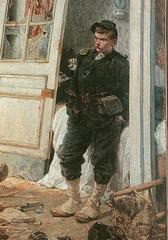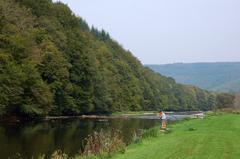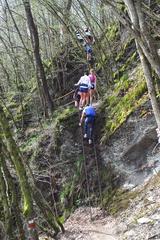Complete Guide to Visiting Château d’Herbeumont in Bouillon, Belgium
Publication Date: 19/07/2024
Introduction
Nestled in the enchanting Ardennes forest in the province of Luxembourg, Belgium, the Château d’Herbeumont is an alluring medieval fortress that tells the tale of centuries past. Originally constructed in the 13th century by Jean de Rochefort, this castle served as a crucial military stronghold due to its strategic location overlooking the Semois River. Over its storied history, the Château d’Herbeumont witnessed numerous battles, sieges, and ownership changes, reflecting the shifting power dynamics of the region during the Middle Ages and the Renaissance. Today, the ruins of the château offer visitors a mesmerizing glimpse into medieval architecture, history, and culture. This comprehensive guide aims to provide all the essential information for planning a visit to the Château d’Herbeumont, including its historical significance, visiting hours, ticket prices, travel tips, and nearby attractions. For more detailed information, visitors can refer to the official Herbeumont Tourism website.
Contents Overview
- Historical Background
- Origins and Early History
- Architectural Evolution
- Feudal Significance
- The Wars of Religion
- Decline and Abandonment
- 19th and 20th Century Rediscovery
- Modern-Day Significance
- Visitor Information
- Visiting Hours
- Tickets
- Guided Tours
- Special Events
- Travel Tips
- Getting There
- What to Bring
- Best Time to Visit
- Nearby Attractions
- Bouillon Castle
- Semois River
- Abbey of Orval
- Accessibility
- FAQ
- Conclusion and Call to Action
Historical Background
Origins and Early History
The Château d’Herbeumont, located in the picturesque region of Bouillon, Belgium, has a rich past that dates back to the medieval period. The castle was originally constructed in the 13th century by Jean de Rochefort, a nobleman who sought to establish a stronghold in the Ardennes region. The strategic location of the castle, perched on a rocky promontory overlooking the Semois River, provided a natural defense against invaders and a vantage point for controlling the surrounding territory.
Architectural Evolution
The initial construction of Château d’Herbeumont was characterized by its robust defensive features, including thick stone walls, a keep, and multiple towers. Over the centuries, the castle underwent several modifications and expansions to adapt to changing military technologies and architectural styles. In the 15th century, the castle was significantly reinforced to withstand artillery attacks, a common threat during the period. These enhancements included the addition of bastions and a fortified gatehouse.
Feudal Significance
Throughout the Middle Ages, Château d’Herbeumont played a crucial role in the feudal system of the region. It served as the seat of the lords of Herbeumont, who wielded considerable power and influence over the local populace. The castle was not only a military stronghold but also a center of administration and justice. The lords of Herbeumont collected taxes, administered laws, and provided protection to the surrounding villages in exchange for loyalty and service.
The Wars of Religion
The 16th and 17th centuries were tumultuous times for Château d’Herbeumont, as the region was engulfed in the Wars of Religion. The castle changed hands multiple times between Catholic and Protestant forces, each seeking to control this strategic asset. During this period, the castle suffered significant damage from sieges and battles. Notably, in 1657, the castle was captured and partially destroyed by the troops of Louis XIV of France, marking a turning point in its history.
Decline and Abandonment
Following the destructive conflicts of the 17th century, Château d’Herbeumont entered a period of decline. The castle’s military significance waned, and it was gradually abandoned by its occupants. By the 18th century, the once-mighty fortress had fallen into disrepair, with its walls crumbling and its towers collapsing. The local population scavenged stones from the ruins for building materials, accelerating the castle’s deterioration.
19th and 20th Century Rediscovery
The 19th century saw a renewed interest in the historical and cultural heritage of Belgium, leading to efforts to preserve and study the ruins of Château d’Herbeumont. Archaeologists and historians conducted excavations and surveys to document the castle’s layout and uncover artifacts from its past. These efforts provided valuable insights into the castle’s construction, usage, and the daily lives of its inhabitants.
In the 20th century, the castle became a popular destination for tourists and history enthusiasts. The Belgian government and local authorities undertook conservation projects to stabilize the ruins and make them accessible to visitors. Today, Château d’Herbeumont stands as a testament to the region’s rich history and serves as a window into the medieval past.
Modern-Day Significance
Château d’Herbeumont is now a protected historical site, attracting thousands of visitors each year. The castle’s ruins offer a glimpse into the architectural and military innovations of the medieval period. Visitors can explore the remnants of the keep, the gatehouse, and the defensive walls, all while enjoying panoramic views of the Semois Valley.
The castle also hosts various cultural events, including medieval reenactments, historical lectures, and art exhibitions, which help to bring its storied past to life. These events provide an immersive experience for visitors, allowing them to connect with the history and heritage of the region.
Visitor Information
Visiting Hours
Château d’Herbeumont is open to visitors from 10 AM to 6 PM daily. However, it is recommended to check the official Herbeumont Tourism website for any changes to the schedule.
Tickets
Entrance tickets can be purchased on-site or online. Prices are as follows: Adults - €6, Children (6-12 years) - €3, and children under 6 enter for free.
Guided Tours
Guided tours are available and can be booked in advance through the official website. These tours provide in-depth historical insights and are available in multiple languages.
Special Events
The castle hosts several special events throughout the year, including medieval fairs, concerts, and historical reenactments. Details and dates for these events can be found on the official website.
Travel Tips
Getting There
Château d’Herbeumont is easily accessible by car and public transport. It is a 30-minute drive from Bouillon and a 2-hour drive from Brussels. Public buses also connect Herbeumont with nearby towns.
What to Bring
Comfortable walking shoes are recommended due to the uneven terrain. Don’t forget your camera to capture the stunning views and historical structures.
Best Time to Visit
The best time to visit is during the spring and summer months when the weather is pleasant, and the surrounding landscape is in full bloom.
Nearby Attractions
Bouillon Castle
A short drive away, Bouillon Castle is another fascinating historical site worth exploring. It offers breathtaking views and a deep dive into the region’s medieval history.
Semois River
Enjoy a relaxing boat ride or a scenic hike along the Semois River, which provides beautiful vistas and a tranquil escape into nature.
Abbey of Orval
Located within an hour’s drive, this picturesque abbey is known for its rich history and delicious Trappist beer.
Accessibility
Château d’Herbeumont is partially accessible to visitors with mobility impairments. While some areas may be challenging due to the ruins’ uneven terrain, efforts have been made to make key sections accessible. For detailed accessibility information, it’s best to contact the site directly or check the official website.
FAQ
What are the opening hours of Château d’Herbeumont? Château d’Herbeumont is open daily from 10 AM to 6 PM. It is advisable to check the official website for any schedule changes.
Are there guided tours available? Yes, guided tours are available and can be booked in advance through the official website. These tours are offered in multiple languages.
How much are the tickets? Ticket prices are €6 for adults, €3 for children aged 6-12, and free for children under 6.
What should I bring when visiting? Comfortable walking shoes and a camera are recommended. The terrain can be uneven, so comfortable attire is advisable.
Conclusion and Call to Action
Plan your visit to Château d’Herbeumont today and immerse yourself in the rich history and stunning landscapes of this medieval fortress. For more information, download our mobile app Audiala, check out related posts, and follow us on social media for updates and travel tips. Don’t miss out on this unique historical experience!
For more detailed information on the history and significance of Château d’Herbeumont, you can visit the official Herbeumont Tourism website.
Sources and Further Reading
- Exploring the Château d’Herbeumont - History, Visiting Hours, and Tickets, 2024, Herbeumont Tourism Source
- Explore Château d’Herbeumont - History, Visiting Hours, and Tickets in Bouillon, Belgium, 2024, Herbeumont Tourism Source
- Ultimate Guide to Visiting Château d’Herbeumont - Hours, Tickets, and Tips, 2024, Herbeumont Tourism Source


